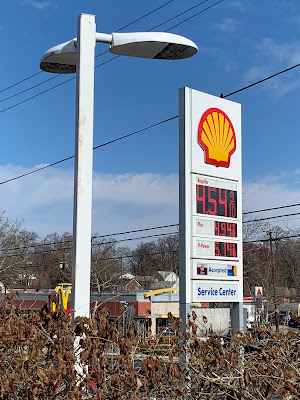 |
| By the time you see this photo, these prices will have changed. |
What does it take to make people change their behavior?
As an economics major in college, I learned a lot about what can change human behavior. When the cost of something goes down, more people will do it; when the cost goes up, fewer. The popularity of some products or activities is very much dependent on cost (elastic), and there are also products or behaviors that are nearly, but not entirely, immune to cost (inelastic). In an example of the latter, smokers gotta smoke almost regardless of the cost of tobacco; in an example of the former, the sudden easy and cheap availability of vaping products drew a whole wave of young people to that bizarre but somehow attractive practice.
After several years of near stability, the price of gasoline increased significantly over the past year and then shot up further after Russia invaded Ukraine. The consumption of gasoline by most people is relatively inelastic (drivers gotta drive), so people find more of their spending now going toward filling the tank. However, in the case of many people, this increasing expenditure can be sustained only for so long; sooner or later, something has to change. Even on a consumption curve as inelastic as gasoline’s, there will come a time when people reduce their consumption in the face of higher prices. Driving behavior will change.
Cost is not the same thing as price, as even economists know; types of ‘cost’ can include emotional, psychological, interpersonal, or any of the other categories of our existence that cannot be measured in money. An unbearable increase in any of these costs can lead us to change our behavior.
Maybe I am less vulnerable to cost-based pressure to change my driving behavior because I already drive a 30-mpg compact car, which sits in the carport five or more days each week because I walk to work. Yet I am astonished at Lent’s ability to change my behavior. And I get the impression that I am not alone in this.
What is it about Lent that can change our behavior?
We are only one week in to this Lent, but it isn’t my first rodeo, so I have my suspicions. I think our most inelastic behaviors – eating and drinking, gossiping and complaining, praying and almsgiving – are affected not by a change in cost, but a change in our awareness of that cost. Lent turns our eyes first to our own need for deliverance from our sins, then raises those same eyes to the cross, to see the cost of our redemption.
We adore you, O Christ, and we praise you; for by your holy cross, you have redeemed the world, we say together fourteen times during every pilgrimage around the Stations of the Cross. Each genuflection is an anticipation of that moment on Good Friday when we bend the knee before kissing the crucifix, confronted in vivid color by the personal price paid for us and our salvation by the sinless Son of God, out of His fathomless love for us and with clear-eyed awareness of every casual, careless, or cruel sin you and I would commit in the course of our days. That cost runs red down His arms and over his feet, dropping down onto our desperate heads and outstretched hands. His loss of blood leaves Him drained of life and color, but leaves us purified of sin, and death. Looking up, we behold the price of that Most Precious and life-giving drink for which we thirst.
To enjoy the sweet fruit of the Cross of Christ, we have to come close to the tree. To lay claim to the mercy that makes our life possible we have to turn away, for a moment or for forty days, from all our priorities and preoccupations, and confront the price of that mercy. The breathtaking beauty of the sacrifice we see can make us lose interest, for a moment or for forty days, in turning back to those priorities and preoccupations. We know, deeply and silently, that before Him, we want for nothing.
But what will it take to make us change our behavior?
Monsignor Smith